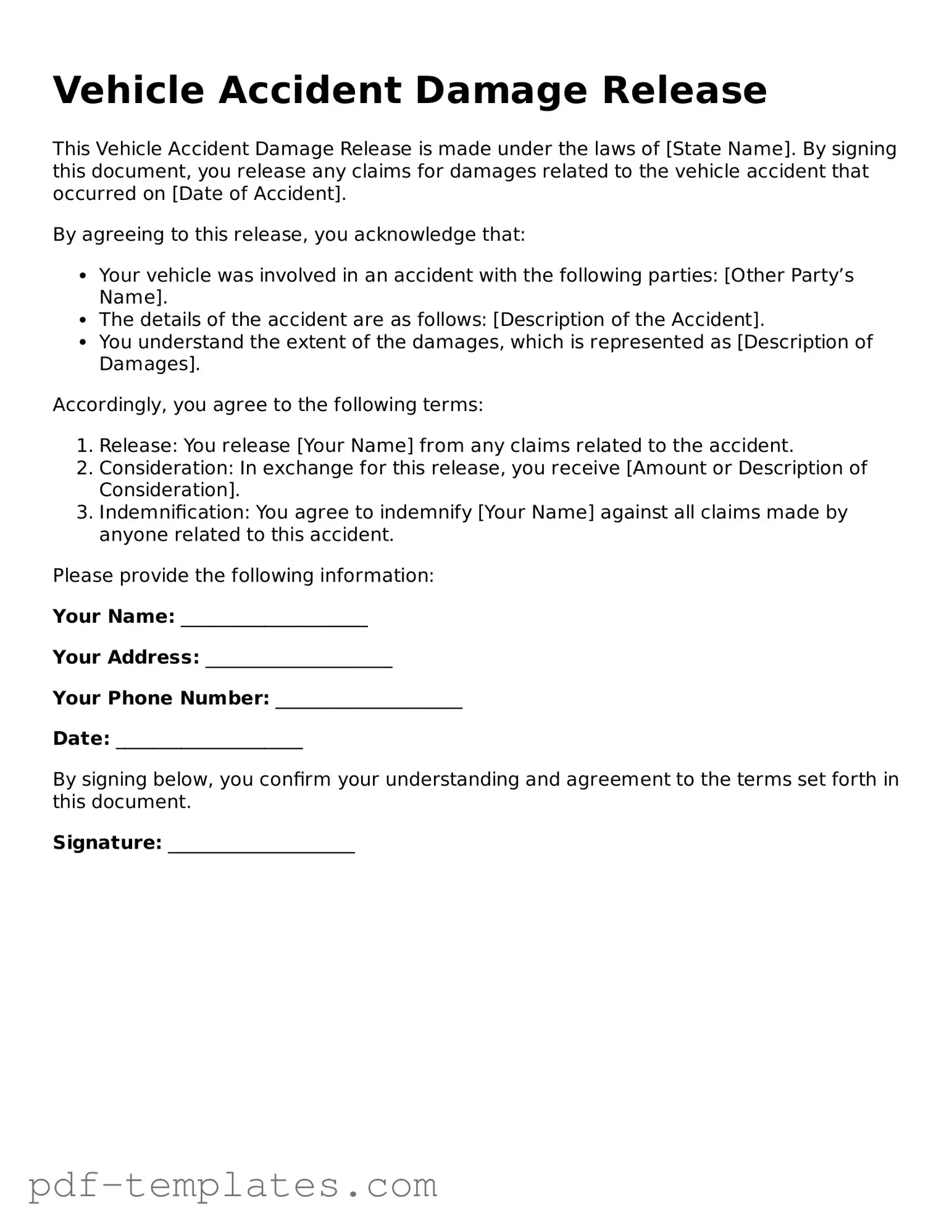The Vehicle Accident Damage Release form shares similarities with a Release of Liability form. Both documents serve to protect one party from future claims related to an incident. When a person signs a Release of Liability, they agree not to hold another party responsible for any damages or injuries that may arise from a specific activity or event. This is particularly relevant in recreational activities but can also apply to vehicle accidents, ensuring that the releasing party relinquishes their right to pursue legal action after compensation has been agreed upon.
Another document akin to the Vehicle Accident Damage Release form is the Settlement Agreement. This document outlines the terms under which parties agree to settle a dispute without going to court. Similar to a damage release, a Settlement Agreement typically includes a clause where the injured party agrees to release the other party from any further claims related to the incident. This helps both parties avoid lengthy litigation and provides a clear resolution to the matter.
The Waiver of Subrogation is another related document. This form prevents an insurance company from pursuing a third party for recovery of costs after paying a claim. In vehicle accidents, if a driver signs a Waiver of Subrogation, their insurer cannot seek reimbursement from the other driver involved in the accident. This is similar to the Vehicle Accident Damage Release form in that it limits future claims and clarifies the responsibilities of each party.
A Confidentiality Agreement often accompanies a Vehicle Accident Damage Release form. This document ensures that the details of the accident and any settlement remain private. Like the damage release, it aims to protect the interests of the parties involved by preventing the disclosure of sensitive information, which can be crucial in maintaining reputations and avoiding public scrutiny.
The Indemnity Agreement is also similar, as it involves one party agreeing to compensate another for any losses or damages incurred. In the context of vehicle accidents, this can mean that one party agrees to cover costs related to damages or injuries, thus limiting the liability of the other party. This agreement provides a layer of protection that is akin to what is found in a Vehicle Accident Damage Release form.
A Mutual Release Agreement is another document that closely resembles the Vehicle Accident Damage Release form. In this case, both parties agree to release each other from any claims or liabilities stemming from the accident. This mutual understanding helps to settle disputes amicably and ensures that both parties can move forward without lingering concerns about future claims.
The Non-Disclosure Agreement (NDA) can also be likened to the Vehicle Accident Damage Release form. While NDAs are often used in business contexts, they can also apply to personal situations, including vehicle accidents. An NDA ensures that the parties involved do not disclose any details about the accident or the terms of the settlement, thereby protecting both parties' interests in a similar manner to a damage release.
The Liability Waiver is another document that serves a similar purpose. Often used in various activities, it releases one party from liability for injuries or damages that may occur. In the context of vehicle accidents, it functions similarly to the Vehicle Accident Damage Release form by ensuring that one party cannot claim damages against the other after a settlement has been reached.
Understanding the nuances of various legal documents is crucial, especially when engaging in activities that may pose risks. One particularly important document is the Release of Liability form, which serves to protect individuals and organizations from bearing responsibility for injuries or damages that may occur. For more information, you can visit georgiapdf.com, where you can find resources related to this essential form.
Lastly, the Claim Release form is closely related. This document is specifically designed for individuals to release a claim against another party, often after receiving compensation. Like the Vehicle Accident Damage Release form, it formalizes the agreement that no further claims will be made regarding the incident, providing closure for both parties.
